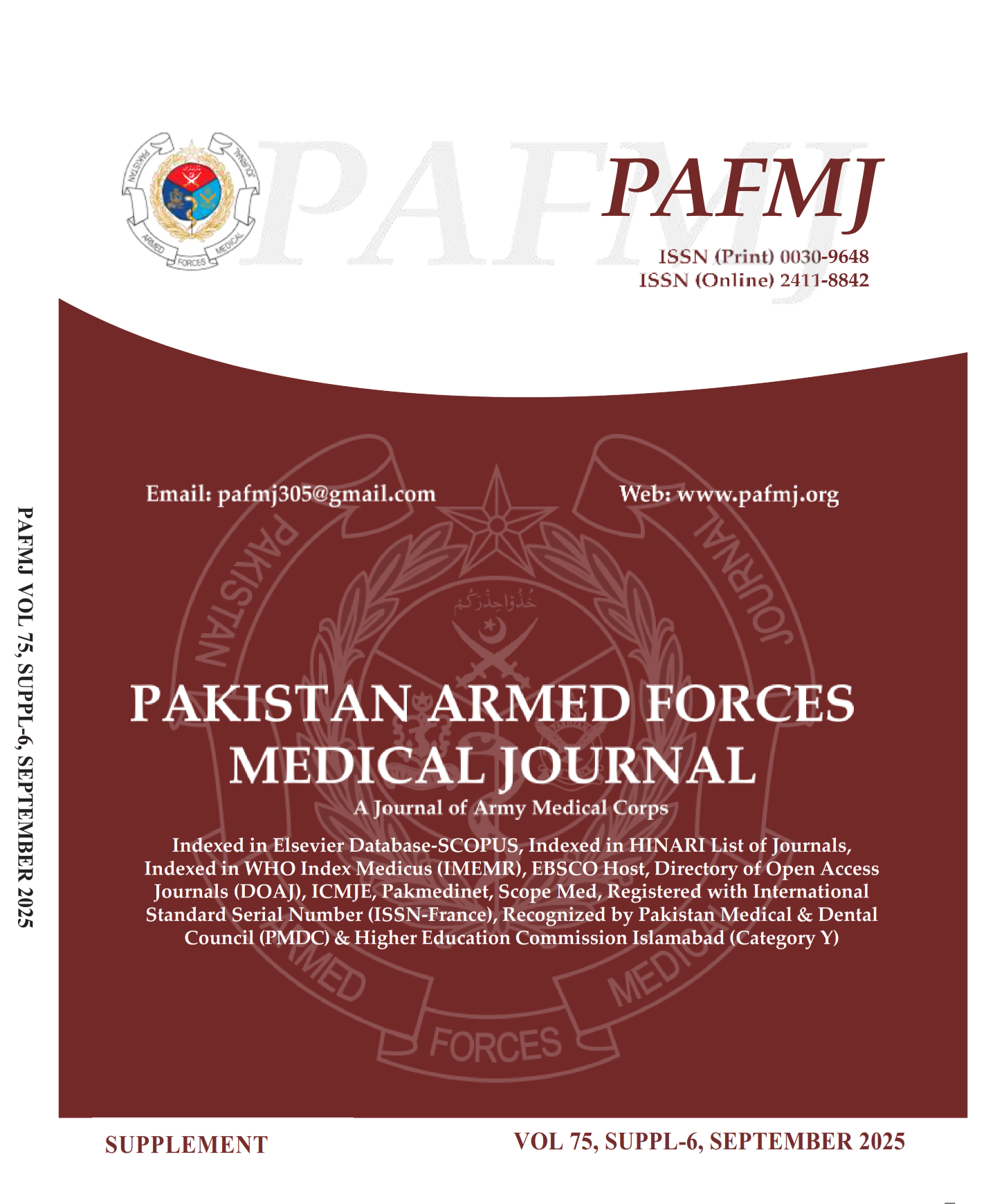Outcome of Neonates Given Therapeutic Hypothermia For Severe Birth Asphyxia
DOI:
https://doi.org/10.51253/pafmj.v75iSUPPL-6.8672Keywords:
Encephalopathy, Hypothermia, NeonateAbstract
Objective: To evaluate outcomes in neonates afflicted with severe birth asphyxia provided with therapeutic hypothermia.
Study Design: Comparative prospective study.
Place and Duration of Study: Military Hospital Rawalpindi from Jan 2018 to Dec 2018.
Methodology: 124 birth asphyxiated neonates were enrolled with further segregation in Group A (Cases) and Group B (Controls). Group A neonates were instituted therapeutic hypothermia with specialized equipment (Techotherm Machine). Complications (such as hemorrhage, infections, hepatic injury, and mortality) were noted and subsequently neurological examinations at six, and twelve months were done to look for hypoxic-ischemic encephalopathic symptoms in both groups.
Results: 124 birth asphyxiated neonates were admitted, and procedure was initiated at 3.45 hour approx. Rectal temperature was recorded to be 33.41 ± 0.5°C. It was found that neonates in Group A have lesser hypoxic-ischemic encephalopathic and other complications than neonates in Group B i-e thrombocytopenia (A: 16(26.3%), B:23(36.8%), hepatic injury (A: 23(36.8%), B: 35(57%) and acidosis (A: 13(21%), B: 23(36.8%). Pulmonary hypertension 19(31%) which was more prevalent in Group B and bradycardia 56(90%) was incessant in Group A due to hypothermia. A follow up neurological exam at six and twelve was observed to be normal in 35(56%)of patients in group A whereas only 25(41%) showed a normal response in group B.
Conclusion: Therapeutic hypothermia can succor as a paradigmatic treatment modality for asphyxiated neonates, if instituted well in time and appropriately. Based on available resources and protocols, guidelines can be established regarding active or passive cooling.
Downloads
References
1. Thomas N, Abiramalatha T, Bhat V, Varanattu M, Rao S, Wazir S, et al. Phase Changing Material for Therapeutic Hypothermia in Neonates with Hypoxic Ischemic Encephalopathy - A Multi-centric Study. Indian Pediatr. 2018; 55(3): 201-205. Epub 2017 Dec 14. PMID: 29242417.
2. Abdo RA, Halil HM, Kebede BA, Anshebo AA, Gejo NG. Prevalence and contributing factors of birth asphyxia among the neonates delivered at NigistEleni Mohammed memorial teaching hospital, Southern Ethiopia: a cross-sectional study. BMC Pregnancy and Childbirth. 2019; 19(1): 1-7.
3. Workineh Y, Semachew A, Ayalew E, Animaw W, Tirfie M, Birhanu M. Prevalence of perinatal asphyxia in East and Central Africa: systematic review and meta-analysis. Heliyon. 2020 Apr 26; 6(4): e03793. https://doi: 10.1016/j.heliyon.2020.e03793.
4. Prashantha YN, Suman Rao PN, Nesargi S, Chandrakala BS, Balla KC, Shashidhar A. Therapeutic hypothermia for moderate and severe hypoxic-ischaemic encephalopathy in newborns using low-cost devices - ice packs and phase-changing material. PaediatrInt Child Health. 2019; 39(4): 234-239. https://doi: 10.1080/20469047.2018.1500805.
5. Stafford TD, Hagan JL, Sitler CG, Fernandes CJ, Kaiser JR. Therapeutic Hypothermia During Neonatal Transport: Active Cooling Helps Reach the Target. Ther Hypothermia Temp Manag. 2017; 7(2): 88-94. https://doi: 10.1089/ther.2016.0022.
6. Lugli L, Balestri E, Berardi A, Guidotti I, Cavalleri F, Todeschini A, et al. Brain cooling reduces the risk of postneonatal epilepsy in newborns affected by moderate to severe hypoxic-ischemic encephalopathy. Minerva Pediatr (Torino). 2021; 73(2): 150-158. https://doi: 10.23736/s0026-4946.18.05224-6.
7. Torre N, Behrsin J, Leslie A. Servo-controlled cooling during neonatal transport for babies with hypoxic-ischaemic encephalopathy is practical and beneficial: Experience from a large UK neonatal transport service. J Paediatr Child Health. 2019; 55(5): 518-522. https://doi: 10.1111/jpc.14232.
8. Procianoy RS, Corso AL, Longo MG, Vedolin L, Silveira RC. Therapeutic hypothermia for neonatal hypoxic-ischemic encephalopathy: magnetic resonance imaging findings and neurological outcomes in a Brazilian cohort. J Matern Fetal Neonatal Med. 2019; 32(16): 2727-2734. https://doi: 10.1080/14767058.2018.1448773.
9. Purkayastha J, Lewis LE, Bhat RY, Anusha KM. Feasibility and Safety of Therapeutic Hypothermia and Short-Term Outcome in Neonates with Hypoxic-Ischemic Encephalopathy. Indian J Pediatr. 2016; 83(2): 175-7. https://doi: 10.1007/s12098-015-1829-9.
10. Al Amrani F, Marcovitz J, Sanon PN, Khairy M, Saint-Martin C, Shevell M. Prediction of outcome in asphyxiated newborns treated with hypothermia: Is an MRI scoring system described before the cooling era still useful? Eur J Paediatr Neurol. 2018; 22(3): 387-395. https://doi: 10.1016/j.ejpn.2018.01.017.
11. Maoulainine FMR, Elbaz M, Elfaiq S, Boufrioua G, Elalouani FZ, Barkane M. Therapeutic Hypothermia in Asphyxiated Neonates: Experience from Neonatal Intensive Care Unit of University Hospital of Marrakech. Int J Pediatr. 2017; 2017: 3674140. https://doi: 10.1155/2017/3674140.
12. Sarnat HB, Sarnat MS. Neonatal encephalopathy following fetal distress. A clinical and electroencephalographic study. Arch Neurol. 1976 Oct; 33(10): 696-705. https://doi: 10.1001/archneur.1976.00500100030012.
13. al Naqeeb N, Edwards AD, Cowan FM, Azzopardi D. Assessment of neonatal encephalopathy by amplitude-integrated electroencephalography. Pediatrics. 1999; 103(6 Pt 1): 1263-71. https://doi: 10.1542/peds.103.6.1263. pmid: 10353940.
14. Cornette L. Therapeutic hypothermia in neonatal asphyxia. Facts Views Vis Obgyn. 2012;4(2):133-9.
15. Kinoshita AN, Magalhães M, Rodrigues DP, Variane GFT, Pietrobom RFR, Gallaci CB, et al. Effectiveness of reaching and maintaining therapeutic hypothermia target temperature using low-cost devices in newborns with hypoxic-ischemic encephalopathy. Anat Rec (Hoboken). 2021; 304(6): 1217-1223. https://doi: 10.1002/ar.24615.
16. Xu EH, Claveau M, Yoon EW, Barrington KJ, Mohammad K, Shah PS, et al. Neonates with hypoxic-ischemic encephalopathy treated with hypothermia: Observations in a large Canadian population and determinants of death and/or brain injury. J Neonatal Perinatal Med. 2020;13(4):449-458. https://doi: 10.3233/npm-190368.
17. Sarafidis K, Soubasi V, Diamanti E, Mitsakis K, Drossou-Agakidou V. Therapeutic hypothermia in asphyxiated neonates with hypoxic-ischemic encephalopathy: A single-center experience from its first application in Greece. Hippokratia. 2014;18(3):226-30.
18. Abate BB, Bimerew M, Gebremichael B, Mengesha KA, Kassaw M, GebremeskelT. Effects of therapeutic hypothermia on death among asphyxiated neonates with hypoxic-ischemic encephalopathy: A systematic review and meta-analysis of randomized control trials. PLoS One. 2021;16(2):e0247229. https://doi: 10.1371/journal.pone.0247229.
19. Shankaran S, Laptook AR, Pappas A, McDonald SA, Das A, Tyson JE, et al.Effect of Depth and Duration of Cooling on Death or Disability at Age 18 Months Among Neonates with Hypoxic-Ischemic Encephalopathy: A Randomized Clinical Trial. JAMA. 2017;318(1):57-67. https://doi: 10.1001/jama.2017.7218.
20. Gulczynska EM, Gadzinowski J, Kesiak M, Sobolewska B, Caputa J, Maczko A, et al. Therapeutic hypothermia in asphyxiated newborns: selective head cooling vs. whole-body cooling - comparison of short-term outcomes. Ginekol Pol. 2019;90(7):403-410. https://doi: 10.5603/gp.2019.0069.
Downloads
Published
Issue
Section
License
Copyright (c) 2025 Hafsa Asad, Asma Razzaq, Umair Ahmed, Misbah Fakih, Rabia Khalid, Sana Jabeen

This work is licensed under a Creative Commons Attribution-NonCommercial 4.0 International License.















